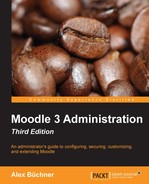The gradebook is one of the most important constructs of any virtual-learning environment. If it's formal, any form of assessment (formative, interim, or summative) is supported and Moodle is no exception. A gradebook is a container that holds grades for all the learners in Moodle. The flexibility and customizability of the Moodle gradebook results in a very high degree of complexity. As a consequence, there are a huge number of administrator settings at your disposal that affect the way teachers, trainers, and assessors use grades throughout the system.
The majority of settings are tightly linked to the gradebook and the related reports are dealt with by teachers at course level. A site-wide agreement on default values and global settings for grades should be in place for your organization.
Additionally, the inline help for each setting is very comprehensive, as is the accompanying area in the Moodle Docs at https://docs.moodle.org/en/Grader_report, which contains a number of pages that are dedicated to administrators. We only briefly describe each section (submenu) in the Grades area in the Site administration section and highlight some key parameters, which are listed as follows:
- General settings: These are parameters that influence the gradebook and grades in general. A setting that is turned off by default and is required regularly is Enable publishing (the ability to publish results via external URLs). Another setting that is changed frequently is Navigation method, in which most users prefer the Tabs option as it is consistent with the rest of Moodle.
- Grade category settings: Grades are organized into categories and, here, you can set the relevant settings.
- Grade item settings: These are settings that impact individual grades and grade items.
- Scales: Here, you can specify site-wide scales that are used for the purpose of grading and rating. The global scales are often linked to qualifications that are offered by your organization. Most sites remove the provided Separate and Connected ways of knowing scale as it doesn't map to their learning environment.
- Each scale comprises a name, the scale itself (a list of comma-separated items), and an optional description. Scales can be uploaded indirectly via the Outcome menu at the course level.
- Outcomes: Outcomes are used by most vocational and some academic curricula to specify the expected competencies or goals of a subject that is being taught. Outcomes have to be enabled in the Advanced features link.
- You can either add global (standard) outcomes one by one, or create a CSV file and upload it in the batch mode from the Outcome menu at the course level (select the Import as standard outcome option).
- Each outcome comprises a full name, short name, scale, and an optional description. The import file supports certain values in its header, such as
outcome_name,outcome_shortname,outcome_description,scale_name,scale_items, andscale_description. - There are plans to improve outcomes and competencies in the near future, so keep an eye on the release notes of future versions.
- Letters: A lot of education systems use a system of letters (A, A-, B+, …, and F) to grade items. Here, you specify which percentage range corresponds to which grading letter.
- Report settings: Moodle comes with a number of predefined gradebook reports. The respective settings determine the appearance and content of the reports. If additional user-defined reports (plugins) are installed in your system, this list is likely to have a separate configuration page for each report type (a good tutorial on how to create your own custom reports can be found at https://docs.moodle.org/dev/Gradebook_reports). The different types of reports are:
- Grader report: This setting includes whether to show calculations, show or hide icons, column averages, and so on. Teachers can override most of the settings in the My report preferences tab.
- Grade history: The gradebook keeps track of all the changes that are made to the gradebook entries. Here, you can specify how many entries will be displayed on the page. You can Disable grade history by going to Server | Cleanup. On the same page, you can also specify the length of time that the grade history should be kept (Grade history lifetime).
- Overview report: This consists of two settings that determine whether the ranking information is shown and how to deal with totals that contain hidden grades, respectively.
- User report: This shows the settings that determines whether the ranking information is shown and how to deal with hidden items.
We have only touched on the customization options of the gradebook. Some Moodle Partners run courses that are dedicated to the management of the usage of the gradebook and any of its related functionalities.
